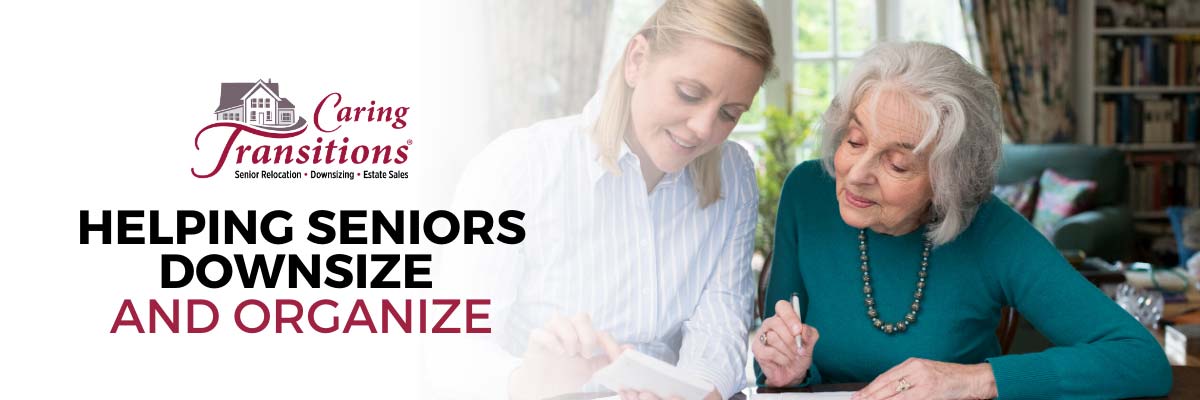
If you noticed that Mom, Dad or Grandma are not quite themselves, you are likely not alone. As older adults constantly live longer and have higher quality of life, it becomes more noticeable when that begins to change for those you love.
Some of the most common signs of health decline are:
- Weight Loss
- Loss of Appetite
- Changes in Mobility
- Decreased Social Interaction
- Decline in Personal Hygiene
- Waning Interest in Grooming
- Mood or Demeanor Changes
- Issues with Balance
- Loss of Home Maintenance
Many family members and friends often notice signs of physical and mental decline but overlook those signs because they don’t know how to start the discussion or preparation for downsizing or rightsizing a loved one.
How to Discuss Getting Organized to Downsize and Rightsize
Communicate with care, patience and respect.
Before approaching your loved one, put this important conversation in perspective. Think of the major changes the rightsizing process will make in their life and help them concentrate on what they will gain instead of what they will lose. Some of the major benefits of downsizing include reduced clutter, more safety and comfort, and streamlined household maintenance.
Discuss the process with family and friends to create a support system.
Talk to your family members and family friends about your parents or loved one’s downsizing needs. Help them understand why this is a decision that will make a positive impact on their quality of life. Be open about a schedule that will minimize one person bearing the burden of downsizing your parent’s personal belongings and emphasize the progress you can make with your family’s help.
Decide what the goals will be for downsizing and rightsizing.
Aside from the intangible quality of life goals, it is important to set realistic timeline goals for what items or rooms you want to clear or reduce clutter in. Survey each room and decide if it is easier to declutter by category of items or room-by-room. Keep in mind some spaces may be easy to declutter while other items will take more time, patience and thought. Consider starting with rooms and items that are not tied to strong emotions or memories first.
Discuss rules for what items will be moved to the new space based on needs, wants and sentimental importance.
Give your parent or loved one a bit of control by including them in rule creation for what stays and what will go. Start with items that are everyday life necessities, then move on to items they believe they cannot let go of. This will help them understand why certain items will need a new home. Items that should be discarded most often will be duplicate objects, and broken, worn or outdated items that are no longer useful or functional.
How to Get Organized: Turn the Plan into Action
After communicating the need and benefits with your parents and family members, solidify your plans for organizing their home and work in phases to put your plan into action. Working in phases will allow you and your support team to make the downsizing or rightsizing move more manageable.
Start the process by removing items that are admittedly unneeded.
Encourage your loved one to let go of items they agree are unnecessary. Reiterate the positive benefits of the items finding new use with charities, people in need, or those fascinated by the items.
Next, clear the clutter.
Most households acquire a host of cherished and treasured items over time that are connected to fond memories. Decluttering can reduce the level of upkeep and maintenance of your home from challenging to manageable.
Decide on convenient places to keep high use items in their new space.
Make the most used areas of your loved one’s home a priority for decluttering and organizing. Pay attention to their preferences. Then choose clear dedicated spaces in their new home for the items they love and use most. The more convenient the placement the better.
Use decorative and multipurpose storage options.
Some of the items cluttering Mom or Dad’s home like baskets, photo frames, or serving carts can be repurposed to create stylish extra storage options. Pulldown shelving can be mounted in cabinets and closets to bring hard to reach shelves to your loved one’s level if mobility is an issue.
Continue to declutter in weekly and monthly intervals to prepare for the move.
Execute the routine and schedule you discussed to make downsizing simpler for your parent(s) or loved one. Keep everyone inspired by ensuring decluttering, sorting, and organized tasks are limited to 2-3 hours on agreed upon days. This will help create manageable routines and expectations for everyone involved.
The downsizing process can be overwhelming for both seniors and their families. If the process is a burden, families should consider hiring companies like Caring Transitions to manage their move, get the home organized, and help your senior loved one get resettled. Many times, this can include the harder part of the process like sorting belongings, packing, managing the move, arranging estate sales or online auctions and even unpacking and arranging items in the new home.
Sources